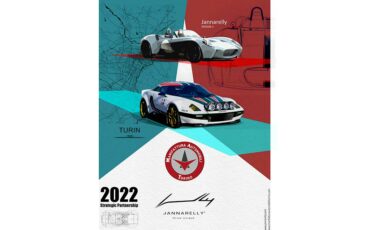
The automotive world witnesses a groundbreaking moment as the AGTZ Twin Tail Chassis #00 makes its global static debut at FuoriConcorso. This remarkable collaboration between La Squadra and Zagato showcases the evolution of a modern automotive icon, transformed into a stunning sculpture by merging art and engineering seamlessly.
Unveiled initially as a scale model at Zagato’s historic Milan Atelier in February, the AGTZ Twin Tail has now transitioned into a full-fledged show car. This prototype chassis #00 offers a glimpse into a limited run of 19 bespoke creations, blending aesthetics with high performance.
“Our project is dedicated to people looking for something extraordinary in automotive design,” said Jakub Pietrzak, Founder of La Squadra. “We aim to cater to those who view cars through an artistic lens, beyond the ordinary.”
The AGTZ Twin Tail draws inspiration from the A220 racecar, which underwent a dramatic transformation from a longtail to a shorttail configuration. This dual personality is a key feature of the AGTZ Twin Tail, allowing owners to switch between the elegant longtail and the muscular shorttail with a removable rear deck, turning it into a unique piece of automotive art when not in use.
Making its static debut at FuoriConcorso on May 25-26, 2024, the AGTZ Twin Tail will have its dynamic debut in July at a major automotive event, with customer deliveries starting in October 2024.

Innovation in Design
The AGTZ Twin Tail features cutting-edge carbon fibre bodywork with a removable tail section designed for ease of transformation. This innovation ensures that the car’s weight remains comparable to its base model, allowing for a swift change between the two configurations. The car’s dimensions shift from 4305mm in shorttail form to 4799mm in longtail form, enhancing aerodynamic efficiency and high-speed stability.
With a top speed exceeding 250km/h and a 0-100km/h acceleration in under five seconds, the AGTZ Twin Tail combines speed with versatility. A custom-made trolley aids in the physical transformation, showcasing the car’s rear deck as a standalone piece of art.
A Tribute to Automotive Heritage
The AGTZ Twin Tail pays homage to the iconic A220 racecar, celebrating both its longtail and shorttail configurations. This tribute will be highlighted at FuoriConcorso, where both A220 chassis will be displayed, enriching the static debut with a historical perspective.
“Running this kind of project is akin to reading a captivating book, filled with plot twists and emotional highs,” said Pietrzak. “Our journey from design sketches to a functional prototype in just 12 months has been exhilarating, and we are honoured to see our prototype blessed by its original inspiration.”
A New Era for Coachbuilding
This collaboration marks a bold step in modern coachbuilding, with only 19 AGTZ Twin Tails to be meticulously crafted over a 1000-hour build process at Zagato’s headquarters. Prices start at €650,000, with a plethora of customization options available to ensure each car is a unique masterpiece.
Customers can choose from 19 colours and nine liveries, with the option for bespoke paint-to-sample finishes. Performance upgrades include carbon wheels, panels, and an enhanced 252hp 1.8-litre turbo engine, along with improved suspension and braking systems.
“The automotive industry is evolving rapidly,” Pietrzak noted. “Design will play a crucial role in differentiating brands. AGTZ Twin Tail exemplifies this new direction, where artisan coachbuilders can create distinct, standout projects.”
Andrea Michele Zagato, President of Zagato, added, “This project embodies enjoyment and innovation. The AGTZ Twin Tail is a testament to our heritage and our ability to push the boundaries of automotive design. We are excited to meet our clients and deliver a car that harmonizes with our legacy.”
The AGTZ Twin Tail stands as a testament to the power of collaboration and the enduring allure of automotive art. Its dual configurations, innovative design, and homage to racing heritage make it a unique addition to the world of high-end automobiles. As it prepares for its dynamic debut and subsequent deliveries, the AGTZ Twin Tail promises to leave an indelible mark on the history of automotive design. AGTZ Twin Tail. One car. Two souls.


















